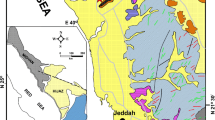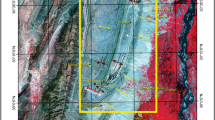Abstract
Through a systematic study on trace elements and REE geochemistry of mudstone deposited in the basin and lower slope environments during Upper Proterozoic to Triassic in the Southwest Yangtze Massif, three geochemical abnormal horizons of which the geochemical characteristics are quite different from those of other horizons have been established for the first time. They are the Lower Cambrian, the Upper Devonian and the Upper Permian. As compared with the crustal evolution in this area, these three geochemical abnormal horizons are corresponding to the pulling-apart periods of geotectonic cycles, which illustrates that the uncommon depositional sources pouring into the basin from the earth’s interior may be one of the most important causes to originate the geochemical anomalies in these horizons. Thus it can be realized that the geochemistry of post-Archean sedimentary rocks has a great deal to do with the crustal evolution and it can be used as a tracer to analyze the crustal evolution. The elements in this area are mainly concentrated in these geochemical abnormal horizons, and the degree of enrichment and deficiency of trace elements in other horizons is very limited. A series of research on mineralization indicates that the main strata-bound ore deposits discovered in the Southwest Yangtze Massif occur in the Cambrian, Devonian and Permian-Triassic strata. The results of isotope tracer research have also proved that most of the metallogenic elements in these ore deposits came from the host strata, which illustrates that the geochemical abnormal horizons may have made great contributions to these ore-forming processes. Thus it can be concluded that it is only the particular horizons corresponding to the particular periods of earth’ s evolution that can they be the significant source beds because only in these uncommon horizons there can be highly enriched metallogenic elements, which may be one of the most important reasons for explaining the time-bound nature of mineralization.
Similar content being viewed by others
References
He Lixian, Zeng Ruolan, and Lin Liqing, 1993, Geology of auriferous deposits in Guizhou: Beijing, Geological Publishing House, p. 25–88 (in Chinese).
Korotev, R.L., 1987, National Bureau of Standards coal flyash (SRM 1633a) as a multielement standard for instrumental neutron activation analysis: Proc. Internat. Symp. Nucl. Anal. Chem., J. Radioanal. Nucl. Chem., v. 110, p. 159–177.
McLennan, S. M. and S. R. Taylor, 1980, Th and U in sedimentary rocks: crustal evolution and sedimentary recycling: Nature, v. 285, p. 621–624.
McLennan, S.M., S.R. Taylor, M.T. McCulloch, and J.B. Maynard, 1990, Geochemical and Nd-Sr isotopic composition of deep-sea turbidites: crustal evolution and plate tectonic associations: Geochim. Cosmochim. Acta, v. 54, p. 2015–2050.
McLennan, S. M. and S. R. Taylor, 1991, Sedimentary rocks and crustal evolution; tectonic setting and secular trends: J. Geology, n. 1, p. 1–21.
Nance, W.B. and S. R. Taylor, 1976, Rare-earth element patterns and crustal evolution I: Australian post-Archean sedimentary rocks: Geochim. Cosmochim. Acta, v.40, p. 1539–1551.
Pu Xinchun, Zhou Haoda, Wang Xilin et al., 1993, Permian lithofacies paleogeography and mineralization in South China; Beijing, Geological Publishing House, p. 1–110 (in Chinese).
Tu Guangzhi, 1993. Ore deposit geochemistry, in Institute of Geochemistry, Chinese Academy of Sciences, ed., Annual Report of Open Laboratory of Ore Deposit Geochemistry, Chinese Academy of Sciences (1992): Beijing, Seismological Press, p. 1–10 (in Chinese).
Tu Guangzhi et al., 1993, Proterozoic basement evolution and mineralization in South China: Beijing, Science Press, p. 1–50 (in Chinese).
Wang Liting, Lu Yanbang, Zhao Shijiu et al., 1994, Permian lithofacies paleogeography and mineralization in South China: Beijing, Geological Publishing House, p. 20–80 (in Chinese).
Wu Yinglin, Zhu Hongfa, Zhu Zhongfa et al., 1994, Triassic lithofacies paleogeography and mineralization in South China: Beijing, Geological Publishing House, p. 1–120 (in Chinese).
Yu Bingsong, 1996, A study on the geochemical background of mineralization in the Southwest Yangtze Massif: A post-doctoral research at Institute of Geochemistry, Chinese Academy of Sciences, unpublished.
Zeng Yunfu, Zhang Jinquan, Liu Wenjun et al., 1993, Devonian lithofacies paleogeography and mineralization in South China: Beijing, Geological Publishing House, p. 1–80.
Author information
Authors and Affiliations
Rights and permissions
About this article
Cite this article
Bingsong, Y., Yuzhuo, Q. & Juan, L. Geochemistry of sedimentary rocks and its relation to crustal evolution and mineralization in Southwest Yangtze Massif, China. Chin. J. Geochem. 17, 265–274 (1998). https://doi.org/10.1007/BF02834603
Issue Date:
DOI: https://doi.org/10.1007/BF02834603




